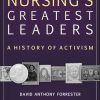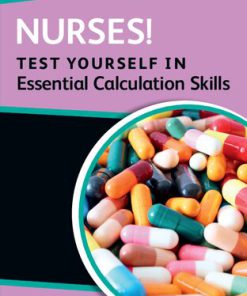Essential Clinical Skills Enrolled Nurses 5th Edition by Joanne Tollefson, Gayle Watson, Eugenie Jelly, Karen Tambree ISBN 9780170454087 0170454088
$50.00 Original price was: $50.00.$25.00Current price is: $25.00.
Essential Clinical Skills Enrolled Nurses 5th Edition by Joanne Tollefson, Gayle Watson, Eugenie Jelly, Karen Tambree – Ebook PDF Instant Download/Delivery: 9780170454087 ,0170454088
Full download Essential Clinical Skills Enrolled Nurses 5th Edition after payment

Product details:
ISBN 10: 0170454088
ISBN 13: 9780170454087
Author: Joanne Tollefson, Gayle Watson, Eugenie Jelly, Karen Tambree
Essential Clinical Skills Enrolled Nurses 5th Edition Table of contents:
Part 1: Hand Hygiene
Chapter 1.1: Hand hygiene
Part 2: Assessment
Chapter 2.1: Head-to-toe assessment
Chapter 2.2: Risk assessment and risk management
Chapter 2.3: Temperature, pulse and respiration (TPR) measurement
Chapter 2.4: Blood pressure measurement
Chapter 2.5: Pulse oximetry
Chapter 2.6: Blood glucose measurement
Chapter 2.7: Neurological observation
Chapter 2.8: Neurovascular observation
Chapter 2.9: Pain assessment
Chapter 2.10: 12-lead ECG recording
Part 3: Activities of Daily Living
Chapter 3.1: Professional workplace skills – including time management, rounding and personal stress management
Chapter 3.2: Bedmaking
Chapter 3.3: Assisting the patient to ambulate
Chapter 3.4: Assisting the patient with eating and drinking
Chapter 3.5: Assisting the patient to maintain personal hygiene and grooming needs – sponge (bed bath) with oral hygiene, hair wash in bed, eye and nasal care
Chapter 3.6: Assisting the patient to maintain personal hygiene and grooming – assisted shower (chair or trolley), undressing/dressing, shaving, hair and nail care
Chapter 3.7: Assisting the patient with elimination – urinary and bowel elimination
Chapter 3.8: Urine specimen collection and urinalysis
Chapter 3.9: Faeces assessment and specimen collection
Chapter 3.10: Assisting the patient with colostomy care
Chapter 3.11: Patient comfort – pain management (non-pharmacological interventions – heat and cold)
Chapter 3.12: Positioning of a dependent patient
Chapter 3.13: Preventing and managing pressure injuries
Chapter 3.14: Active and passive exercises
Chapter 3.15: Deep breathing and coughing, and use of incentive spirometer
Part 4: Asepsis and Wound Care
Chapter 4.1: Aseptic technique – establishing a general or critical aseptic field
Chapter 4.2: Simple dry dressing using a general aseptic field
Chapter 4.3: Wound irrigation
Chapter 4.4: Wound swab
Chapter 4.5: Packing a wound – ‘wet-to-moist’ dressing
Chapter 4.6: Negative pressure wound therapy (NPWT) dressing
Chapter 4.7: Suture and staple removal
Chapter 4.8: Drain removal and shortening
Chapter 4.9: Gowning and gloving (open and closed)
Chapter 4.10: Surgical scrub (surgical hand wash)
Chapter 4.11: Chest drains and underwater seal drainage (UWSD) management
Part 5: Medication
Chapter 5.1: Medication administration – oral, sublingual, buccal, topical and rectal
Chapter 5.2: Medication administration – eye drops or ointment, and eye care
Chapter 5.3: Medication administration – injections
Chapter 5.4: Medication therapy – inhaled medication (metered-dose inhalers and nebulisers)
Chapter 5.5: Medication administration – via an enteral tube
Part 6: Intravenous Care
Chapter 6.1: Venepuncture
Chapter 6.2: Peripheral intravenous cannula (PIVC) – assisting with establishment
Chapter 6.3: Peripheral intravenous cannula (PIVC) and therapy (PIVT) management
Chapter 6.4: Removal of a peripheral intravenous cannula (PIVC)
Chapter 6.5: Intravenous medication administration – adding medication to PIVC fluid bag
Chapter 6.6: Intravenous medication administration – adding medication to a burette
Chapter 6.7: Intravenous medication administration – injection (bolus)
Chapter 6.8: Central venous access device (CVAD) dressing
Chapter 6.9: Blood transfusion management
Part 7: Documentation
Chapter 7.1: Documentation
Chapter 7.2: Nursing care plans
Chapter 7.3: Clinical handover – change of shift
Chapter 7.4: Admission, discharge and patient transfer
Chapter 7.5: Health teaching
Chapter 7.6: Nursing informatics
Part 8: Specific Nursing Care
Chapter 8.1: Oxygen therapy (includes peak flow meter)
Chapter 8.2: Preoperative care
Chapter 8.3: Recovery room care and handover
Chapter 8.4: Postoperative care
Chapter 8.5: Nasogastric tube – gastric drainage
Chapter 8.6: Catheterisation (urinary)
Chapter 8.7: Catheter care (including hourly urine measurement)
Chapter 8.8: Suctioning of oral cavity
Chapter 8.9: Tracheostomy care
Chapter 8.10: Assist a patient to use CPAP in the general ward or community
Chapter 8.11: Nasogastric tube insertion
Chapter 8.12: Enteral feeding (nasogastric and gastrostomy tube)
Chapter 8.13: Infection control – standard and transmission-based precautions
Chapter 8.14: Care of the unconscious patient
Chapter 8.15: Palliative care and end-of-life care
Part 9: Mental Health Care
Chapter 9.1: Mental state examination
Chapter 9.2: Establishing a ‘therapeutic relationship’ in the mental health setting
Chapter 9.3: Management of a client with challenging behaviour (aggressive or violent)
Chapter 9.4: Assist with the management of a client in seclusion
Chapter 9.5: Electroconvulsive therapy (ECT) – client care pre- and post-treatment
People also search for Essential Clinical Skills Enrolled Nurses 5th Edition:
essential clinical skills enrolled nurses pdf
essential clinical skills enrolled division 2 nurses
essential nursing guidelines clinical skills and procedures
essential nursing guidelines clinical skills and procedures pdf
clinical facilitation essential skills and principles
Tags: Joanne Tollefson, Gayle Watson, Eugenie Jelly, Karen Tambree, Essential Clinical Skills
You may also like…
Uncategorized
Psychology - Psychotherapy
Medicine - Neurology
The Clinical Practice of Neurological and Neurosurgical Nursing Joanne V. Hickey
Politics & Philosophy - Cultural
The Invisible Woman: Gender, Crime and Justice 5th Edition Joanne Belkna
Psychology - Cognitive Psychology
Counselling Skills and Theory 5th Edition Counselling Skills And Theory 5Th Edition
Medicine - Clinical Medicine
Medicine - Medicine & Nursing Reference
Clinical Psychomotor Skills (5-Point) 7th Edition by Joanne Tollefson 0170282872 9780170282871
Relationships & Lifestyle - Personal Growth & Inspiration











